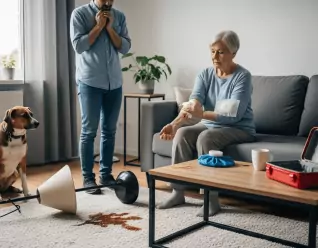

Using Crate Training For Emotional Support Animals
by Tayyaba Amir
Last updated: April 20, 2024
Verified and Approved by:
Angela Morris,
MSW, LCSW
Fact Checked

Are you looking for effective ways to provide comfort and support to those in need? If so, crate training for emotional support animals may be just what you need. Crate training for emotional support animals offers numerous benefits for both the animal and their owner. Not only does it provide a safe and comfortable space for the animal, but it also helps to establish a sense of routine and structure in their daily lives.
For individuals who rely on their emotional support animals for comfort and companionship, crate training can be a valuable tool in ensuring their well-being. By understanding the benefits and following a step-by-step guide to crate training, you can create a harmonious environment for both you and your emotional support animal.
So, let’s explore the world of crate training and discover how it can enhance the bond between you and your furry friend.
Understanding Crate Training for Emotional Support Animals
Crate training is not about confining your animal, but rather providing them with a secure and cozy space that they can retreat to when they need some alone time or a sense of security. It can be especially beneficial for emotional support animals as it gives them a designated spot where they can feel calm and relaxed.
To start crate training, choose a crate that’s the appropriate size for your animal. It should be big enough for them to comfortably stand, turn around, and lie down in. Place soft bedding inside the crate to make it extra cozy and inviting. Introduce your animal to the crate gradually, using positive reinforcement techniques such as treats, praise, and toys. Encourage your furry friend to explore the crate on their own terms, making it a positive and rewarding experience for them.
Crate training should never be used as a form of punishment. It should always be a safe and comfortable space for your emotional support animal to retreat to when they needs some quiet time or a sense of security. By using crate training in a positive and gradual manner, you can create a space where your furry friend feels safe, loved, and supported.
Benefits of Crate Training for Emotional Support Animals
One major advantage of crate training for emotional support animals is that it allows them to have a designated safe space where they can feel secure and relaxed. ESAs often provide comfort and support to their owners, but they also need a place where they can retreat and recharge. A crate provides this safe haven for them. It becomes their own personal sanctuary, a space where they can feel protected and at ease. By having their own designated area, ESAs can have a sense of ownership and control over their environment, which can be extremely beneficial for their emotional well-being.
Another benefit of crate training for emotional support animals is that it helps with their training and behavior. When ESAs are crate trained, they learn to associate the crate with positive experiences and feelings. This can help them develop good habits and behaviors, as they see the crate as a place where they receive rewards and praise.
Crate training also helps with potty training, as it teaches ESAs to hold their bladder and eliminate outside of the crate. This can be especially important for emotional support animals that accompany their owners on flights or in public places, as they need to have good bathroom manners. By providing a safe and secure space, crate training sets the foundation for a well-behaved and well-adjusted emotional support animal.
Step-by-Step Guide to Crate Training your Emotional Support Animal
To successfully crate train your emotional support animal, start by gradually introducing them to the crate and making it a positive and comfortable space for them. Research shows that dogs who view their crates as a safe haven are less stressed and anxious when left alone.
Here’s a step-by-step guide to help you crate-train your emotional support animal:
- Step 1: Choose the right crate: Select a crate that is the appropriate size for your animal and provides enough room for them to stand up, turn around, and lie down comfortably. Make sure it’s well-ventilated and secure.
- Step 2: Introduce the crate gradually: Start by placing the crate in a familiar and comfortable area of your home. Leave the door open and encourage your animal to explore it at their own pace. Use positive reinforcement, such as treats or praise, to create a positive association with the crate.
- Step 3: Create a cozy space: Line the crate with comfortable bedding and add some of your animal’s favorite toys or blankets. Make sure the crate is clean and free from any hazards. This will help your animal feel safe and secure in their crate.
- Step 4: Establish a routine: Set a consistent schedule for crate time, including regular meal times and bathroom breaks. Gradually increase the amount of time your animal spends in the crate, starting with short intervals and gradually working up to longer periods. Always make sure to provide plenty of exercise and mental stimulation outside of the crate.
Overcoming Challenges in Crate Training for Emotional Support Animals
Despite the difficulties involved, successfully acclimating your emotional support animal to a crate requires patience and consistency. Crate training can be challenging, especially if your animal has never been in a crate before or has a fear of confined spaces. However, with the right approach and a little bit of time, you can help your furry friend feel comfortable and secure in their crate.
One common challenge in crate training is separation anxiety. Many emotional support animals form strong bonds with their owners and can become anxious when left alone. To help your animal overcome this challenge, it’s important to gradually introduce them to the crate and associate it with positive experiences. Start by leaving the crate open and placing treats or toys inside to entice your animal to explore. Once they are comfortable entering the crate, gradually increase the amount of time they spend inside, starting with just a few minutes and gradually working up to longer periods. By gradually increasing the time spent in the crate, you can help your emotional support animal feel more at ease and less anxious when left alone.
Another challenge in crate training is resistance or fear of the crate. Some animals may initially resist entering the crate or show signs of fear or anxiety when inside. To overcome this challenge, it’s important to create a positive association with the crate. Use treats, toys, or praise to reward your animal for going into the crate, and gradually increase the time they spend inside. You can also try using a calming pheromone spray or diffuser in the area around the crate to help your animal feel more relaxed. Additionally, make sure the crate is comfortable and inviting with soft bedding and familiar scents. With time and patience, your emotional support animal can learn to view the crate as a safe and comforting space.
Incorporating a 2 column and 3-row table into this section can help make the information more enjoyable and relatable. Here is an example:
| Challenge | Solution |
|---|---|
| Separation anxiety | Gradually increase time spent in crate, associate crate with positive experiences |
| Resistance or fear of the crate | Create positive associations, use treats and praise, make crate comfortable and inviting |
Alternatives to Crate Training for Emotional Support Animals
Luckily, there are other methods available for nurturing the well-being of your furry companions. While crate training may not be suitable for every emotional support animal, there are alternatives that can provide them with a comfortable and safe space.
Here are three options to consider:
- Playpen: A playpen is a great alternative to a crate as it offers a larger space for your emotional support animal to move around and play. It can be set up in a designated area of your home and can be customized with toys, blankets, and other items that your furry friend enjoys. This allows them to have more freedom and can help alleviate any anxiety they may feel when confined to a crate.
- Doggy Den: A doggy den is a cozy and enclosed space that serves as a safe haven for your emotional support animal. It can be a small tent-like structure or even a designated corner of a room that is set up with their favorite bedding and toys. This provides them with a sense of security and comfort, without the restrictions of a crate.
- Pet Gate: If your emotional support animal doesn’t require confinement but still needs boundaries, a pet gate can be a great option. This allows them to have access to a specific area of your home while still ensuring their safety. You can set up their bed, food, and water in this designated space, providing them with a sense of their own territory.
By exploring these alternatives to crate training, you can find a method that best suits the needs of your emotional support animal. The goal is to create an environment that promotes their well-being and comfort, while still maintaining boundaries and safety.
Frequently Asked Questions
Can crate training be used for all types of emotional support animals?
Yes, crate training can be used for all types of emotional support animals. It provides a safe space where they can feel secure and calm, enhancing their overall well-being and helping them serve as reliable companions.
Is crate training suitable for older or senior emotional support animals?
Crate training can be beneficial for older or senior emotional support animals. It provides them with a safe and comfortable space, symbolizing security and stability. This helps them feel calm and supported, enhancing their emotional well-being.
How long does it typically take for an emotional support animal to adjust to crate training?
Typically, it takes time for emotional support animals to adjust to crate training. Every animal is unique, so be patient and understanding. Gradually introduce the crate, provide comfort, and use positive reinforcement. Remember, their well-being is worth the effort!
What should I do if my emotional support animal shows signs of distress or anxiety during crate training?
If your emotional support animal shows distress or anxiety during crate training, it’s important to address their needs. Start by creating a positive association with the crate, using treats and comfort items. Gradually increase crate time and provide reassurance.
Are there any specific crate training techniques that work best for different types of emotional support animals, such as dogs versus cats?
For dogs, positive reinforcement techniques like treats and praise work wonders. Cats, on the other hand, need a slow and patient approach. Use treats and toys to create positive associations with the crate.
Certify Your Emotional Support Animal Today

Why You Can Rely on Us?
At Wellness Wag, we believe your pet deserves care rooted in both science and compassion. Each article is carefully researched, written in clear language for pet owners, and then reviewed by qualified professionals to ensure the information is evidence-based, current, and practical for real-life care. Our goal is to help you feel confident in making informed decisions about your pet’s health and well-being.
Reviewed by
Angela Morris, MSW, LCSW
Angela is a licensed clinical social worker with 20 years of experience in patient advocacy and community mental health. She has assisted numerous clients with ESA evaluations and brings a deep understanding of disability accommodations, ensuring that all information is accurate, supportive, and practical.

Written by :
Tayyaba Amir
Last Updated :
April 20, 2024












